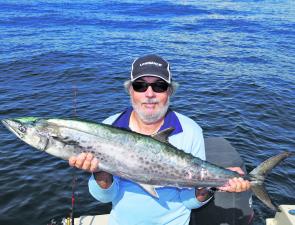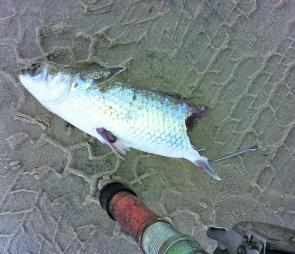The beaches, lower estuaries and inshore reefs reach a peak of activity this month and if the wind and sea can stay down, everyone will have some fun.
There have already been some great beach sessions on bream, whiting and the odd cruising flathead. All it took was a week or so of minimal rainfall and calm seas and then most of the beach fishos hit paydirt.
Anyone who has some beachworms or live yabbies has scored well on fat whiting, although the voracious little dart can strip a bait from a hook in seconds if a bunch find your offering first.
At prime time – top of the tide late in the afternoon – it’s been a bite a cast when conditions are calm.
The entire 32km of beach from Evans Head north to Ballina has been a chain of holes, banks and gutters, with increasingly nervous pods of mullet cruising the shore break.
Those mullet remaining in the rivers should be running to sea early this month and there should be big schools off the beaches although the net crews, sharks and jewfish will take their toll. Let’s hope they all leave enough for the fish to breed sustainably.
Tailor are becoming a bit more common whenever there’s any baitfish in the holes and gutters and this month is usually a hot one for big greenbacks after dark on bonito or tuna strips.
The professional pipi harvest is also due to resume north of Broadwater this month. As far as I am aware, there is to be no pro harvest south to Evans.
There have been fair numbers on the beach at Evans Head at times but it doesn’t seem to take long for them to be harvested just by rec fishers.
If indeed the law is that these pipis are for bait only and mustn’t be removed beyond 50m of the high-tide mark, then the current bag limit of 50 is a joke in poor taste. Even with the dart hordes at their peak, it’s impossible to go through 50 pipis in a beach session.
This month the grey nomads from Melbourne and Adelaide will be back to grub out bagfuls and take them back to the caravan park for wasted bait or for food, too. After them comes the Fishing Classic for another hiding.
The short days and long nights encourage the snapper to head inshore to feed and gather ahead of the spawning season. Especially just after a blow, there should be good numbers of fish of all sizes in as little as 5m depths.
Soft plastics really come into their own in this sort of water, especially first thing in the morning, but it can be difficult to select the right tackle.
Go too light and you’ll certainly get plenty of takes but if you’re fishing around hard reef the big fish will bury you all too often. Mind you, a couple of years ago I was still getting well and truly dusted on my 50lb red bass popping outfit…
Depending on the water temps, we could still see a run of mackerel this month, too. It wasn’t many years ago that the spotties crowded the ‘Middle Ground’ between Kahors and the South Reef in June and while there is some sort of bait around the reefs and the water is relatively clear, the Spanish don’t ever seem too far away.
Those icy dark nights also mean mulloway on the reefs, with cricket-score captures possible for the pro line fishers and for a bunch of enthusiastic shamateurs hell-bent on lining their pockets. Both camps have already made some big hits; let’s just hope the Fisheries flying squad makes a few of its own.
The Richmond River estuary should get decidedly longer over the next few months. After six months of almost incessant rain – Lismore has notched up nearly 900mm this year already – it doesn’t take much more than some drizzle to put another fresh in Ol’ Muddy.
Most Ballina river fishos are still on the same tank of fuel they started in February, because they haven’t been able to get much upstream of Burns Point before they hit fresh dirt, er, water.
The bream won’t care; any that haven’t already been working along the breakwalls and beaches will be in the lower river anyway because it’s spawning season.
The big night tides this month bring it all to a head and if you’re a bream, the Richmond from the ferry downstream will be a ‘Sea of Lurv’.
Best bream results will come to those using blades and plastics down deep during the day and mullet strips and gut or salted tuna at night.
Estuary perch will also be increasingly encountered in the same water so respect the law and let them swim away unharmed to do their own thing.
A live yabby drifted around after dark will also tempt whiting, luderick and soapy jew, all of which have been in reasonable numbers lately around the rock walls, holes and weedy shallows.
There have been more than the usual numbers of flathead along the beaches but we can expect the school fish to move upstream with the increasing salinity.
Reads: 1932
If the water remains clear and reasonably warm, spotted mackerel won’t be out of the question.

Snapper come right into the shallows this month but it can take some work to get the big ones out.

Russell Farley and young Luca clean some of the quality bream they caught at the new Evans Head boat ramp.

A mullet along the beach has a limited life expectancy. If it’s not the netters or the jewies, it’s the sharks.




